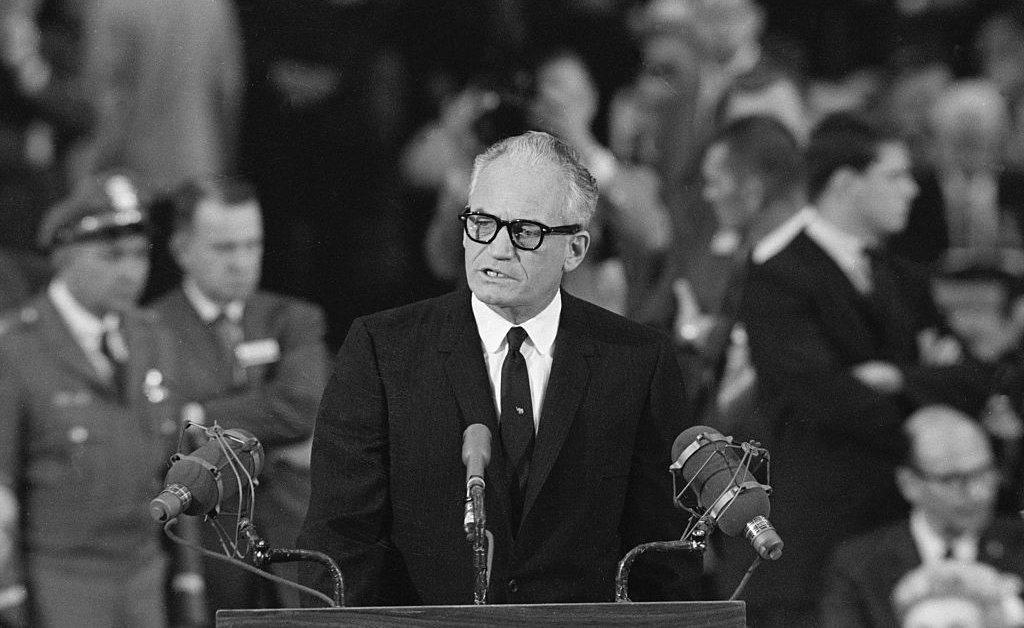The Republican National Convention is underway in Milwaukee. It comes on the 60th anniversary of the 1964 convention — a raucous affair at the Cow Palace in San Francisco. There, the GOP nominated Arizona Senator Barry Goldwater, revealing that the conservative wing of the party was ascendent. Sixteen years later, the right scored a crowning victory when Ronald Reagan captured the presidency.
The 1964 convention shocked observers. Goldwater’s supporters heaped abuse on the media and moderate Republicans who refused to endorse the nominee. It was a stark digression from the typical convention, in which a newly crowned nominee and his allies extended olive branches to all wings of the party. In 1960, for example, Goldwater had scolded conservatives who didn’t want to endorse Vice President Richard Nixon, exhorting them to get on board.
But the vitriolic display, full of conspiracy theories and extremism, embodied the brand of conservatism on the rise in the GOP — one that now dominates the party.
Conservatives grew increasingly disgruntled during the 1950s as they watched the Republican President Dwight Eisenhower accept the welfare state and display a willingness to coexist with the Soviet Union. This spurred the mobilization of a grassroots movement determined to reassert its values, with the help of conservative media outlets like National Review and the radio program the Manion Forum of Opinion, as well as hard-right groups like the John Birch Society.
Read More: Exclusive: Donald Trump Says Political Violence ‘Depends’ on ‘Fairness’ of 2024 Election
By the early 1960s, the conservative movement saw the GOP as their vehicle for pushing the country to the right and Goldwater as their standard-bearer. Fury over national Democrats’ embrace of the Civil Rights movement gave them new allies: Southern white arch-conservative Democrats who had aligned with the racist legacies of the former Confederacy. Lyndon Johnson did not exaggerate when after signing the Civil Rights Act of 1964 he conceded to aide Bill Moyers, “Well, I think we may have lost the south for your lifetime — and mine.”
That year, savvy grassroots strategy helped the right dominate the process for selecting Republican convention delegates, which set the stage for what happened in San Francisco.
One of the Convention’s defining moments came when New York Governor Nelson Rockefeller, a pro-civil rights Republican who lost to Goldwater in the primaries, addressed the Cow Palace crowd.
Knowing his audience was stacked against him — but also aware that the convention was on television nationwide — Rockefeller forged ahead, “prodding,” what journalist Theodore White dubbed “a den of hungry lions,” and describing how he had fought “to keep the Republican Party the party of all the people and warning of the extremist threat.”
White, the legendary election chronicler, captured the scene: the Goldwater crowd exploded, “hating and screaming and reveling in their own frenzy.” Rockefeller struggled to make himself heard as he decried the Goldwater campaign tactics, including the “anonymous midnight and early morning telephone calls, unsigned threatening letters, smear and hate literature, strong-arm and goon tactics, bomb threats and bombings.”
Rockefeller was not the only Republican to get shouted down. When Pennsylvania senator Hugh Scott proposed amending the GOP platform to repudiate right-wing extremism, the Goldwater delegates “sounded a thunderous ‘no’” and the proposal failed.
Even Eisenhower got caught up in the Goldwater moment. He wound up the convention-goers by attacking the media for being biased against conservatives. The delegates “stood in their chairs, shouting, raving, shaking their fists and cursing the reporters in the press section.”
The highlight of the convention was Goldwater’s acceptance speech in which he proclaimed that “extremism in defense of liberty is no vice” and that “moderation in pursuit of justice is no virtue.”
Left unsaid was what liberty and justice meant to Goldwater and his supporters. His opposition to the Civil Rights Act (CRA) just weeks earlier offered a strong clue; liberty and justice were reserved for White Americans like them. He predicted that the CRA — legislation that authorized the federal government to end the systematic denial of full freedom to African Americans — would lead to the “destruction of free society.”
While observers saw the 1964 campaign as a devastating blow to the right wing of the GOP given Goldwater’s landslide defeat, it didn’t extinguish the anger driving conservatives or their determination to fight back against forces they perceived to be destroying America.
That became clear the following year as the U.S. escalated its military presence in Vietnam.
In response to the first antiwar demonstrations, conservative pro-war groups marched down Fifth Avenue in New York City in October 1965. The New York Times reported that 25,000 took part in a parade that included William F. Buckley — founder of National Review — Medal of Honor winners, marching bands, fife and drum corps, and floats featuring signs reading “Bomb Hanoi.” Other signs proclaimed, “Fight the Reds in Vietnam and in New York City,” showing that the goal of the march was not simply to make a statement on foreign policy.
The heated rhetorical exchanges of the 1964 Republican convention became physical altercations in 1965. The New York Times reported that “burly longshoremen and veterans left the line of march to attack those who voiced antiwar viewpoints.”
Read More: Startling New Poll Finds Political Violence Gaining a Mainstream Foothold
One bystander, Murray Rothfield, upon observing a sign with a picture of a nuclear bomb and the words, “Let’s Drop It!” replied “in a loud voice, ‘Let’s not drop it.’” For this, “[s]everal veterans jumped over the public barricade and punched him to the ground.” Rothfield was livid. The “Buckley goons are free to roam the streets and the whole thing has Brown Shirts overtones,” referring to the paramilitary forces Hitler used as enforcers in the 1930s.
The Washington Post reported that bystander Armand Storace held up a sign that read “Profits Equals Murder.” One of the marchers yelled, “Traitor, traitor,” prompting members of the International Longshoreman’s Association to beat Storace, opening up a “wide gash” on his head. Storace, the New York Times reported, was “knocked to the ground” whereby “his assailants ripped off his clothes and kicked him. Several men shouted ‘kill him’ and ‘string him up.’”
It’s no coincidence that the Anti-Defamation League that same month reported a “sharp rise” in Ku Klux Klan membership, especially outside the south. In November, The New York Times reported that membership in the John Birch Society was also flourishing. The Society’s publicity director, John H. Rousselet, announced that he had added a new lecturer to their publicity wing: James G. Clark, the Selma, Alabama, sheriff who helped direct the vicious attack on John Lewis and the other marchers crusading for voting rights on the Edmund Pettus Bridge just months before.
From the tenor of the 1964 GOP convention to the growing popularity of the Ku Klux Klan and the John Birch Society, the conservatives’ embrace of violent rhetoric and political bullies took root — something that would only increase in the years that followed.
After members of the Ohio National Guard opened fire on antiwar protestors at Kent State in May 1970, killing four, novelist James Michener was stunned by the local resentment against the students. A local attorney confessed that he wished he’d been there “with a submachine gun.” Shortly after the Kent State shootings, construction workers in Manhattan assaulted antiwar protestors in what became known as the “Hard Hat Riot.” Nixon promptly invited the leaders of their unions to the White House for a photo-op.
Even after Watergate damaged the GOP, the tenor remained the same. In 1978, Newt Gingrich, an up-and-coming Republican, lectured young activists that the party still didn’t do enough to “encourage you to be nasty.” As a member of the House of Representatives in the 1980s, Gingrich routinely referred to Democrats as “pro-communist, anti-American, tyrannical.” In 1990, Gingrich provided Republicans with a go-to list to describe all Democrats: “sick, pathetic, lie, anti-flag, traitors, radical, corrupt.” In 1995, Gingrich became Speaker of the House.
Today the Oath Keepers, the Three-Percenters, and the Proud Boys have taken the place of the Klan and the Birchers, and Gingrich proudly supports Donald Trump. During his 2016 campaign, Trump encouraged his rally-goers to “knock the crap” out of hecklers, adding his own desire to “punch [them] in the face.”
Writing for The Atlantic, Ali Breland recently described how after Trump’s conviction in his election interference (or “hush money”) case, MAGA voices on the internet exploded with warnings against anyone they deem an obstacle to Trump’s return to power. It was, Breland noted, not the first time: “The MAGA faithful are once again on the internet threatening violence.”
Even though Goldwater lost in a landslide to Johnson, his RNC convention turned out to be a portent of the emerging temperament and rhetoric that now is a central part of Republican politics. If history cannot always show us how to prevail over looming dangers, it should at least teach us not to be surprised when they appear — or in this case, reappear.
Charles J. Holden is a professor of history at St. Mary’s College of Maryland. His books include Republican Populist: Spiro Agnew and the Origins of Donald Trump’s America (University of Virginia Press, 2019), co-authored with Zach Messitte and Jerald Podair.
Made by History takes readers beyond the headlines with articles written and edited by professional historians. Learn more about Made by History at TIME here. Opinions expressed do not necessarily reflect the views of TIME editors.




